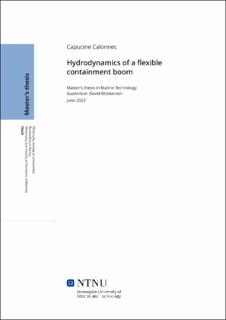| dc.contributor.advisor | Kristiansen, David | |
| dc.contributor.author | Calonnec, Capucine | |
| dc.date.accessioned | 2023-09-21T17:19:30Z | |
| dc.date.available | 2023-09-21T17:19:30Z | |
| dc.date.issued | 2023 | |
| dc.identifier | no.ntnu:inspera:140295966:93995776 | |
| dc.identifier.uri | https://hdl.handle.net/11250/3091178 | |
| dc.description.abstract | Denne masteroppgaven studerer hydrodynamikken til en fleksibel inneslutningsbom. En global modell basert på teori om kabelstrukturer ble utviklet for å estimere deformasjonene til en bomstruktur som møter strøm. Denne globale modellen tar bare hensyn til det horisontale planet. Den bruker kontaktledningsligningen, luftmotstandskraften og stripeteorien for å finne formen strukturen bør ha. For å validere denne modellen ble det utført eksperimenter på en $5 m$ lang fleksibel bom med $30 cm$ dypgang. Strukturen ble slept med hastigheter som varierte mellom $0,08 m/s$ og $0,53 m/s$, noe som tilsvarer et Reynoldstall som varierte mellom $24000$ og $159000$. Bommen ble festet til vognen i begge ender, og det ble utført tester med ulike festebredder på $2,5 m$, $4 m$ og $5 m$. I tillegg ble det gjennomført en numerisk studie ved hjelp av CFD-beregningsprogrammet OpenFOAM. Simuleringene ble utført med det eksperimentelle oppsettet som inngangsverdier og inkluderte ulike representasjoner av bommens skjørt. En flat plate og tre ulike kurver som vender mot en strøm ($0,13 m/s$) med ulike helningsvinkler ble simulert. De numeriske resultatene viser at formen på den nedsenkede membranen har stor innvirkning på den påførte motstandskraften. Derfor må strukturens vertikale dimensjon tas i betraktning i den globale modellen. Ved å inkorporere varierende motstandskoeffisienter langs bommens lengde i den globale modellen, avhengig av kurven og helningsvinkelen, ble det vertikale aspektet til en viss grad tatt hensyn til. En sammenligning mellom denne modellen og den eksperimentelle studien viste at modellen var nøyaktig, men at den kunne trenge en viss utvikling og forbedring. | |
| dc.description.abstract | This master's thesis studies the hydrodynamics of a flexible containment boom. A global model using cable structures theory was built to estimate the deformations of a boom structure facing a current. This global model only takes into account the horizontal plane. It uses the catenary equation, the drag force, and the strip theory to find the shape the structure should take. To validate this model, experiments were carried out on a $5 m$ long flexible boom model with a $30 cm$ draft. The structure was towed at velocities varying between $0.08 m/s$ and $0.53 m/s$ corresponding to a Reynolds number varying between $24000$ and $159000$. The boom was attached at both ends to the carriage and tests were carried out with different attachment widths of $2.5m$, $4m$, and $5m$. In addition, a numerical study was conducted, using the computational fluid dynamics (CFD) solver OpenFOAM. Simulations were performed using the experimental setup as input values and incorporated various representations of the boom's skirt. A flat plate and three different curves facing a current ($0.13 m/s$) with various inclination angles were simulated. The numerical results demonstrate that the shape of the submerged membrane significantly influences the applied drag force. Therefore, the vertical dimension of the structure must be considered within the global model. By incorporating varying drag coefficients along the length of the boom in the global model, dependent on the curve and inclination angle, the vertical aspect was taken into account to some extent. A comparison between this model and the experimental study proved that the model was accurate but could need some development and improvement. | |
| dc.language | eng | |
| dc.publisher | NTNU | |
| dc.title | Hydrodynamics of a flexible containment boom | |
| dc.type | Master thesis | |
